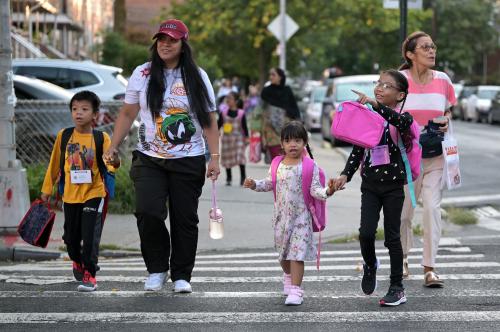Both parties have spoken about the need to focus on children and families during this year’s election cycle. In fact, it has been a talking point for decades in both Democratic and Republican party platforms. Support for children and families is key to the future health of a nation.
Despite this professed commitment, however, approximately 23.6 million young children (0-5 years) in America are at risk of not meeting their developmental potential, draining the country of much-needed human capital. Analyses of the U.S. federal budget indicate very limited investment in children. Overall, data from 2018 to 2024 shows that the share of federal spending on children ranged from 9.71% in fiscal year (FY) 2018 to 12.16% in 2024, with a dip to 7.48% in 2020. Focusing on children under age three, however, indicates a 1.52% federal budget spending in FY 2024. This represented a sliver of the total budget and a decline from an allotment of 1.66% in FY 2023. While the increase in overall spending on children in fiscal year 2024 is welcome news, it falls woefully short of meeting the needs of America’s children and families and is concerning when compared with funding in peer nations around the world.
The result of this checkered pattern of investment is that America ranks last among OECD countries in providing family care and leave, has one of the lowest pre-K enrollment rates with no current universal system in place, last in family-friendly policies, and ranks near the bottom of 41 advanced countries on a series of child wellness markers.
To be fair, the U.S. has taken small steps forward for young children through the Child Tax Credit (CTC), a minor increase in access to licensed childcare centers, an increase in some states for pre-K and family leave. However, these policies offer a piecemeal approach to supporting young children from birth to five years and families and do not offer countrywide, comprehensive coverage. Implementation of many of these initiatives is left to states with uneven consequences. The ultimate result? Child poverty in the U.S. is among the worst in the industrialized nations, and many children in families with fewer resources—who are disproportionately Black and Brown —trail behind their peers from more affluent environments in mental and physical health, education outcomes, and more.
Our wavering commitment to children and families in terms of actionable, comprehensive policies that support children from birth to five years and their families leaves some wondering whether America really cares about its children despite the rhetoric.
This policy brief points to six key areas of investment in which bipartisan action can bring America in line with other nations and make a marked difference in the lives of millions of young children 0-5 years and their families.
We propose bipartisan investment to 1) increase high quality childcare options; 2) increase the availability of quality pre-K; 3) increase programs to mitigate poverty; 4) establish a federal paid family leave policy; 5) increase support for infant and child mental health; and 6) establish a permanent national level body to coordinate multi-sectoral supports for children.
1. High quality child care for birth to 5
Offer access to high quality child care for all children.
Access to childcare (of any kind, be it through stand-alone or religious centers, or formal or informal home-based care) has been a key policy concern and a high demand from American families. More than 20,000 households across America highlighted access to high quality childcare for their children from birth to around 5 years as a top ask of the government.
Despite the demand, research indicates that there is a child care desert where demand far outstrips the availability of quality childcare spaces and staff. The U.S. Census Bureau’s 2022 Household Pulse Survey (HPS) found that 35% of families with children aged 0-4 and 54% of families with children 5-11 had no childcare arrangement. Further, a survey of parents across the country found that “65% of parents who responded have spent time on a daycare center waitlist with 81% of waitlisted parents juggling multiple waitlists simultaneously and 43% waiting four months or longer.” The HPS survey also indicated that 87% of parents that miss work to care for their children are women. But access alone will not help America’s children thrive, as childcare is not merely custodial. Learning begins in nonformal settings from birth, and young children’s brain development is shaped by what they experience in their environment, whether positive or negative. Decades of research support this conclusion. For children to benefit from care, it must be of high quality, and abundant scientific research has determined what counts as such. Generally, high quality care is defined by high adult:child ratios, small groups, adults’ understanding of child development and age-appropriate activities and play materials. These features help ensure that children receive care that is not only supportive, but educational, preparing them for formal education. Research demonstrates that high quality care can have long-lasting effects, with one study showing benefits up to 26 years of age. Beyond the impact for children, investment in high quality childcare is key to supporting families in the workforce.
Additionally, American families are often burdened by the high cost of childcare. The National Database for Childcare Prices, which draws on data across 47 states, found the range for childcare for infants to 12-year-old children to be between $5,357 to $17,171 annually in 2022 dollars. This is equivalent to 8% to 19.3% of median family income. The Department of Health and Human Services (HHS) states that “affordable” childcare costs no more than 7% of a family’s income.
Some federal level measures expand access to high quality childcare (through programs like Early Head Start), but these efforts are piecemeal and not meeting the needs of children nationally. The Office of Child Care within the Administration for Children and Families (ACF) provides block grants such as the Child Care and Development Fund and the Child Care and Development Block Grant (CCDBG) to state, territory, and tribal governments that aim to provide childcare subsidy support for children and families, but this reaches a small percentage of eligible children in the country. The American Rescue Plan approved $24 billion in subsidies to childcare providers to stabilize the industry during COVID-19 and provide a boost to the CCDBG. Part of this expired at the end of 2023, and the boost to CCDBG will expire in September 2024. The 2022 CHIPS and Science Act expands access to childcare through employers. It requires companies applying for $150 million or more in CHIPS grants to provide childcare for their employees. While employer-based care is not a systematic approach to addressing childcare, it has increased access for some.
Other smaller bills that would exacerbate the piecemeal approach to supporting young children and families have been introduced in Congress, but not yet passed. The most substantial is the Child Care Stabilization Act which would provide $16 billion to replenish childcare stabilization funding. Additionally, the H.R. 3639 After Hours Child Care Act has been introduced, which establishes a pilot program through the ACF to award grants to increase the capacity of childcare providers to deliver services where parents are working non-traditional work hours (e.g. before 9AM, after 5PM and over weekends). Lastly, the H.R. 4571 – Child Care Investment Act of 2023 was introduced in Congress which increases employer-provided childcare tax credit.
Cash and noncash policies, expanded upon later in this brief, could provide an avenue to support families that choose to care for their children at home. Sweden, for example, recently passed a law giving grandparents paid parental leave to care for their grandchildren for up to three months of their first year of life. This approach not only enables vital bonding between young children and their caregivers, but it also relieves the childcare system of the costs and responsibility of caring for newborns.
Caring for young children is a personal choice for each family. National policy levers should not dictate the ways in which families should care for children but should provide comprehensive options for families that suit their needs.
2. High-quality early learning: Pre-K for 4-year-olds
Increase access to quality Pre-K for all children and especially for those from underserved communities.
Since the 1990s, discussions about early childcare have morphed into discussions of high-quality early learning in preschools. This is now a Sustainable Development Goal (4.2) that all countries should strive for. Nobel laureate James Heckman says that, “The highest rate of return in early childhood development comes from investing as early as possible…” His calculations suggested up to a 13% return on investment, with the highest returns for the most disadvantaged children. Children who attended high quality preschools on this estimation had better long-term outcomes and saved capital expenditures in special education and remedial education for children throughout formal schooling.
The rate of return depends largely on access to, quality of, and age-appropriateness of opportunities for children. Currently only Florida, Oklahoma, Vermont, and the District of Columbia offer universal pre-K. With limited entry slots, Colorado, Iowa, Maine, Maryland, Michigan, Nebraska, Texas, Vermont, West Virginia, and Wisconsin, join this group. The National Institute for Early Education Research offers a review of access to and quality of high-quality pre-K around the United States. It is clear from this review that access across states is growing (through programs including Head Start) with 35% of 4-year-olds now in pre-K programs. Only half of the states enrolled more children in 2022 than before the pandemic in 2019. However, at 35%, as mentioned previously, only a little over a third of America’s children are enrolled in any pre-K program, let alone a high-quality program.
Regarding quality, characteristics of high quality pre-K and kindergarten parallel those of high-quality early childcare, including teacher specialized training, small class size, and developmentally appropriate curricula. To the later point, the National Association for the Education of Young Children offers guidelines for appropriateness. These guidelines become particularly important in a climate in which economist Daphna Bassok argues that curricula from formal schooling is seeping into pre-K and kindergarten classrooms.
Mixed results from studies on the effects of pre-K make this point clear. The evaluation of Tennessee’s scaled pre-K study by Kelly Durkin and colleagues noted that children who attended pre-K did worse than those that did not on some key outcomes when they entered formal schooling. A closer look at thousands of observations conducted by the study revealed that the classroom practices were not often age appropriate even though they met most of the quality characteristics. Learning experiences were presented in large group formats with passive children – even though research strongly suggests that passive group activities are inappropriate for young children and are negative predictors of outcomes in language, math and literacy. Thus, even though the science is not completely settled, a compelling 2024 review from Margaret Burchinal and colleagues suggests that “…there is evidence of the potential for today’s early education programs to accomplish their goals of improving long term outcomes for many children”. To fully achieve this goal, however, we must continue to understand and to implement the “active ingredients” like age-appropriate curricula and high-quality teacher classroom characteristics that will make this possible. To this end, New Hampshire, Connecticut, and Oklahoma have introduced legislation to ensure age-appropriate instruction through active play-based learning, an approach that is being adopted by many countries around the globe.
The aim of universal, high-quality pre-K is not an independent goal. Rather, the ability of a pre-K program to help all students acquire the knowledge and skills they need to achieve in school depends, at least in part, on the quality of learning and care that those children received in the prior years between birth and age four. Therefore, it is important to acknowledge the need to connect early childcare (usually 0-3 years) and early childhood education (usually 3+ years) through funding and programming to ensure young children receive adequate resources across development. This is particularly urgent for children in underserved communities, who face opportunity gaps from an early age.
3. Mitigating poverty through financial supports
Reduce child and family poverty through tax credits, food assistance, and other family financial support.
Family economic stability is critical for children’s well-being and ability to thrive. Currently, 16% of children are in poverty. While this number has steadily declined from its peak of 23% in 2012, this number still represents approximately 11.6 million children. Poverty can have devastating consequences for children, including poor physical and mental health outcomes, fewer educational opportunities, and reduced opportunities for positive brain development. When poverty compounds other adversities children experience (i.e. divorce, child abuse, parental mental illness, family substance abuse, exposure to violence), they can experience toxic stress, which is significantly more detrimental than regular stress. Toxic stress can impact children throughout their lifetime and “may affect adult physical and psychological health and ultimately exert a great financial toll on our healthcare systems.” Therefore, early attention to programs that mitigate the effects of poverty and toxic stress are key investments for any nation.
Several programs can be expanded or re-enacted to address childhood poverty, including the Child Tax Credit (CTC) and the Supplemental Nutrition Assistance Program (SNAP). Emerging programs that provide unconditional cash to families also show promise around the world. This all helps reduce hardship and provide greater financial stability for families of young children. They also enable families to make choices about how they care for their children.
The CTC, currently worth up to $2,000 per eligible child, offers much-needed financial relief to about 40 million low-to-moderate income families. Data show that the CTC was successful in reducing child poverty. Under the American Rescue Plan Act (ARP), the credit was temporarily increased to $3,600 for children under age 6 and $3,000 for children ages 6-17. Subsequent research showed that 91% of lower income families used their monthly payments to cover their basic household expenses and education costs. That is, families did not squander the funds they received but used them to support the nutrition and health of their children. Further, the expanded CTC temporarily lifted 2.9 million children above of the poverty line. With the current CTC policy set to expire in 2025, federal policymakers should consider renewing key features of the 2021 expansion in a compromise-enhanced manner.
SNAP is available to low-income families who need food-purchasing assistance. According to the 2023 Children’s Budget report, “Children represent more than 40% of SNAP recipients, making it an excellent investment in reducing childhood hunger.” Research shows that increased investments in FY 2022 reduced child poverty by 8.6% in the fourth quarter of 2021 and kept nearly 2.3 million people out of poverty.
Conditional and unconditional cash transfers have long been used around the world and have been shown to reduce poverty and support young children’s development. Their use is gaining recognition as a possible policy lever in America to both reduce family poverty and positively impact young children’s development. Baby’s First Years, an ongoing research project, found that during the first three years of monthly unconditional cash transfers, mothers in the high-cash gift group ($333 per month) invested more money and time in their kids than mothers in the low-cash gifts group ($20 per month). Specifically, the moms in the high-cash gift group spent more money on child-focused expenditures such as books and toys, as well as more time on developmentally supportive early learning activities, such as reading and telling stories to their kids. This further adds to the growing body of evidence which shows that low-income parents often prioritize investing in their kids when given supplemental income.
4. Paid family leave
Provide paid family leave for all workers so they can care for young children.
The United States is one of the only high-income countries that does not have a national paid leave policy that supports families in caring for their newborns or newly adopted children. Twenty-two states have some kind of family leave law at the state level. Thirteen states and the District of Columbia have mandatory paid leave (generally for 12 weeks and accompanied by job protection). Seven other states have a voluntary program that allows it to be sold as part of the private insurance market. However, in March of 2023, only 27% of all American workers had access to paid family leave. Additionally, employees in these states may not have job protection during their leave if they are not covered by the Family and Medical Leave Act.
Extending paid leave to all workers employees would enable parents to adjust to their new babies before returning to work without worrying about financial burdens. A 2012 research from the Center for Women and Work at Rutgers University suggests that women who took advantage of paid leave were more likely to return to work and that they were 39% less likely to receive public assistance and 40% less likely to receive food stamps than those who did not have the advantage of paid family leave. Additionally, a 2020 study found that paid parental leave improved the mental health of parents, decreased infant mortality, and increased the use of breastfeeding.
5. Young children’s mental health
Develop a comprehensive approach to mental health that supports children from birth.
A growing body of evidence emphasizes how the COVID-19 pandemic adversely affected young children around the world. For example, data from the U.S. Centers for Disease Control and Prevention indicated that the proportion of emergency room visits for mental health concerns among children ages 5-11 increased by 24% between March and October of 2019 and 2020. Further research contextualizes young children’s mental health challenges during the pandemic. Robertson and colleagues surveyed racially, ethnically, and linguistically diverse caregivers whose children were ages 0-5 between April and July 2020. This study revealed that caregivers’ own mental health challenges and their own stress from the pandemic were associated with their children’s mental health challenges and social behaviors. The difficulties that caregivers experienced predicted the severity of their child’s temper, argumentativeness, and hyperactivity. When caregivers were stressed about health concerns, economic issues, or relationships, among other factors, their children were more likely to be worried or sad.
Recent research not only indicates the prevalence of young children’s mental health challenges associated with the COVID-19 pandemic but highlights the importance of investing in general mental health so all children can thrive. One recent study demonstrated the importance of providing children with a stable home environment that includes stable family routines and its relationship to later mental health. O’Connor and colleagues then demonstrate how children’s mental health at school entry predicted their academic achievement in third grade.
There are existing federal and state policies that seek to increase children’s access to mental healthcare, though funding offered through these initiatives is often limited. As of August 2023, twenty-one states across the U.S. have expanded their Medicaid programs to cover school-based mental healthcare. For example, Connecticut and New Jersey require school-based behavioral health services to be reimbursable through Medicaid. Additionally, the 21st Century Cures Act created the federal Infant Early Childhood Mental Health Grant Program to help ensure adequate mental healthcare for children and infants who are at risk of mental illness or emotional disturbances. Between 2019 and 2022, the Program supported the delivery of mental health services to over 80,000 children. State-led efforts offer a way forward. Alaskan lawmakers enacted a dedicated mental health budget bill (HB 41) in 2023. The bill supports a lifespan approach to mental healthcare with a focus on caring for infants who face mental health challenges early in life (e.g., fetal alcohol spectrum disorders). Colorado’s I Matter program, initially funded through the ARP and made permanent through state legislation in 2024, is an especially strong model for children’s mental healthcare at the state level. It provides all Coloradans 18 years and younger with six free and confidential therapy sessions with a licensed mental health professional. It is critical to scale these efforts to the national level.
6. A whole child approach to early childhood wellbeing
Expand the Administration for Children and Families (ACF) across multiple sectors to ensure a comprehensive approach to early childhood from birth to 5 in the United States.
While the United States has the ACF, which aims to promote the economic and social well-being of children and families, it is part of the Department of Health and Human Services (HHS). Children’s needs are holistic and span multiple federal departments– including Education, HHS, Commerce, and Housing and Urban Development. The result is that the ACF is limited in its mandate and is not set up to coordinate between the various national level departments critical for children’s holistic development. It also means that programs focused on, for example, childcare and pre-K, are not connected or building on each other. Elevating the ACF as its own permanent, national-level coordinating body that works with cabinet level departments would ensure a comprehensive approach for children’s holistic development. Without a coordinating body that can work across sectors and with other departments, the U.S. invests in piecemeal efforts that lack substantial impact and may not be as cost-effective as they could be.
This recommendation is buttressed by a long history of failed attempts to coordinate holistic well-being for America’s children. In the 1980s, the House had a Select Committee on Children, Youth and Families that was disbanded with changes in administrations. In 1987, President Ronald Regan instituted a National Commission on Children. The commission’s report noted the high cost of failure to provide for the needs of America’s children. It endorsed holistic attention to support income security and child health, and to protect vulnerable children, among others. The commission, led by chairman John D. Rockefeller concluded, “Marginal changes will not turn this system around. Instead, we need comprehensive reform based on fundamental restructuring of our effort to help troubled children and protect vulnerable children.” One notable suggestion from this report was the need for “greater coordination of state programs,” adding the need to have “cross-agency budgeting and planning in order to move funds across agency boundaries and to achieve greater flexibility in organizing and delivering services to families in crisis.” Unfortunately, this recommendation along with the important work of the commission was not enforced as administrations changed and new priorities left young children and families behind.
Other countries have seen some success with national level coordinating bodies. In 2007, Chile’s government implemented Chile Crece Contigo (Chile Grows with You), a comprehensive social program designed to support children and their families from pregnancy through a child’s early years. It offers a wide range of services, including prenatal care, early childhood education, health services, family allowances, and more. Chile Crece Contigo is managed at the national level across ministries–the Ministry of Social Development and Family, the Ministry of Health, and the Ministry of Education. This program is a hallmark example of the potential to have successful multisectoral, national-level coordination for the purpose of creating an integrated network of social services to better support young children and families.
Supporting young children and families
Support for young children and families is support for America and its future. In the immediate aftermath of the 2022 Dobbs v. Jackson Women’s Health Organization Supreme Court decision, data indicates that abortion bans increase births by an average of 2.3% compared to if no bans had been enforced. increase in births overall. This number was higher in Texas (5.1%) and Mississippi (4.4%).
We don’t know for certain what the future holds, but if birth rates continue to rise, the U.S. government will need to think about the future and ensure policies support young children and families. With appropriate comprehensive and targeted investments, we can both talk the talk and walk the walk with respect to the bipartisan support for young children and families.






